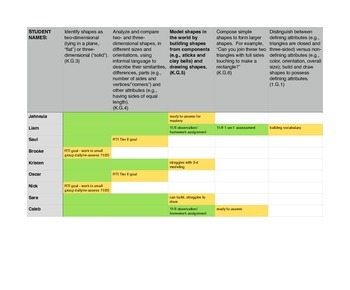Differentiated CCSS Math Progress Monitoring Template - 1st Grade Bundle
Creating to the Core
11 Followers
Grade Levels
1st, Homeschool
Subjects
Resource Type
Standards
CCSS1.MD.A.1
CCSS1.MD.A.2
CCSS1.MD.B.3
CCSS1.MD.C.4
CCSS1.NBT.A.1
Formats Included
- Zip
- Excel Spreadsheets
Pages
19 pages
Creating to the Core
11 Followers
Description
This document contains record keeping templates for each math CCSS standard at the first grade level. It connects standards for remediation and standards for acceleration that align with the focus standard, therefore allowing teachers to track student progress along a logical continuum. This tool can be used for differentiation, RTI goal setting, and daily progress-monitoring.
On each page, the bolded standard is the focus standard - the one that you are currently teaching and assessing at grade level. Standards to the left are the preceding skills necessary in order to master the bolded skill. Those standards can be used to set intervention goals and inform specialized instruction. The standards on the right are for acceleration -- they are the next steps for students who have shown mastery of the bolded standard. This progression crosses grade levels and content strands as necessary.
Please take the time to look at our preview, which will give you a sense (through the sample provided) of one way to use this helpful tool.
On each page, the bolded standard is the focus standard - the one that you are currently teaching and assessing at grade level. Standards to the left are the preceding skills necessary in order to master the bolded skill. Those standards can be used to set intervention goals and inform specialized instruction. The standards on the right are for acceleration -- they are the next steps for students who have shown mastery of the bolded standard. This progression crosses grade levels and content strands as necessary.
Please take the time to look at our preview, which will give you a sense (through the sample provided) of one way to use this helpful tool.
Total Pages
19 pages
Answer Key
N/A
Teaching Duration
N/A
Report this resource to TPT
Reported resources will be reviewed by our team. Report this resource to let us know if this resource violates TPT’s content guidelines.
Standards
to see state-specific standards (only available in the US).
CCSS1.MD.A.1
Order three objects by length; compare the lengths of two objects indirectly by using a third object.
CCSS1.MD.A.2
Express the length of an object as a whole number of length units, by laying multiple copies of a shorter object (the length unit) end to end; understand that the length measurement of an object is the number of same-size length units that span it with no gaps or overlaps.
CCSS1.MD.B.3
Tell and write time in hours and half-hours using analog and digital clocks.
CCSS1.MD.C.4
Organize, represent, and interpret data with up to three categories; ask and answer questions about the total number of data points, how many in each category, and how many more or less are in one category than in another.
CCSS1.NBT.A.1
Count to 120, starting at any number less than 120. In this range, read and write numerals and represent a number of objects with a written numeral.


